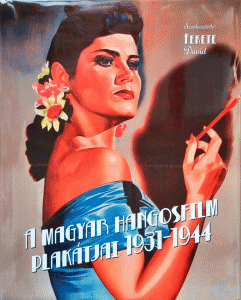
Hungarian Sound Film Posters 1931–1944
Hungarian Sound Film Posters 1931–1944
Edited by Dávid Fekete
NSZL–Dr. Kovács Pál County Library and Community Space,
Budapest–Győr, 2016., 580 pages
ISBN 978 615 805 7103
1931 was a significant landmark in the history of the Hungarian motion picture as it was the year when the first Hungarian sound film, Kék bálvány (Blue Idol) was released. In 2016, to celebrate 85 years of this event, Rómer Flóris Art And History Museum of Győr held an interesting and in many aspects gap-filling exhibition under the title Hungarian Sound Film Posters, 1931-1944, with the expert contribution of NSZL as co-organizer. Now the entire chronologically ordered material of the exhibition (two thirds of which belong to the NSZL Collection of Posters and Small Prints) is published in this beautiful album, a joint project of Dr. Kovács Pál County Library and Community Space and National Széchényi Library, edited carefully by Dávid Fekete. The collection of movie posters from all Hungary is introduced by six studies on sound films and 20th century poster art. The more than 500 items come from the NSZL Collection of Posters and Small Prints, the Hungarian National Digital Archive and Film Institute, and private collections.
Although approximately 360 movies were produced between 1931 and 1944, not all of the posters have remained to posterity. The poster of Kék bálvány is also lost, so the first item in our collection is of a favorite movie of many of us, Hyppolit, a lakáj (Hyppolit, the Butler). Following the chronological line of the posters it can be clearly seen how film producers and artists tried and seduce the audience into the cinemas with the basic idea that only big-sized portraits of the actors can sell a movie. As one of our authors puts it: „It did not matter what kind of movie, if there was a portrait of Pál Jávor or Katalin Karády on the poster, people just wanted to see it.”
Looking at the pictures, there is also room to discuss the popularity of movie stars, comedies, war movies, and war itself. The 1939 anti-Jewish laws caused considerable loss to the flourishing movie industry as popular actors like Gyula Kabos or Zita Perczel were not allowed to play from then on. World War II represents a well noticeable fault line in the history of movies and movie posters. The 577 pages album of impressive volume and colors is completed by an index that enhances our knowledge with even more aspects and details.
Shopping
Our publications are available in our bookshop, or can be ordered from the Publications Department of the NSZL using the contact details below: Főigazgatói Kabinet kiadványtára, Országos Széchényi Könyvtár, 1276 Budapest P.O. box 1205., phone: 06-1-23-23-506, e-mail: kiadvanytar@oszk.hu.




